The Aftermath of Ypres
On May 11th, the 3rd Mons returned briefly to the front line where the commanding officer, Lieutenant-Colonel Gough, was wounded. Major Bridge took command and the battalion moved out of the line to bivouacs at Poperinghe. Here they found piles of parcels from home which it had not been possible to deliver during the battle - most were addressed to men who were no longer alive to receive them.
Casualties between April 22nd and May 8th had been horrendous. Of the 1020 soldiers of the 3rd Battalion the Monmouthshire Regiment who had arrived in France in February 1915, only 134 were left alive on the morning of May 10th. On May 14th, what was left of the battalion was moved to the village of Winnezeele in France for a period of rest and re-organisation.
The 1st and 2nd Battalions of the regiment had also been virtually wiped out at Ypres and, on May 22nd, orders were received for the remains of the three battalions to amalgamate under the command of Major WS Bridge.
On May 24th, the Germans launched a fresh bombardment and infantry attack on Ypres and the battalion again found itself in the front line - this time at the infamous "Hellfire Corner". They were relieved the following day and returned to Vlamertinghe. They were joined by the 2nd Monmouths on May 27th and the official amalgamation of the battalions took place on May 28th.
Hill 60
On February 27th 1915, a detachment of 40 men (all miners in civilian life) under 2nd Lieutenant GW Lancaster – also a mining engineer - was sent to Ypres to join up with men from the 1st Battalion to form a new unit - the 171st Tunnelling Company. Despite the name, which was intended to confuse the enemy, this was the first specialist tunnelling unit formed on the Western Front.
Mining commenced on St. David’s Day in the front line near St. Eloi but had to be abandoned due to a heavy German bombardment. Lieutenant Lancaster was seriously wounded and had to be sent back to Britain. After a few days’ rest in billets, orders were received to start work on mining Hill 60 – so called because its summit stood at 60m above sea level. The British front line lay at the foot of the hill with the German trenches occupying the summit, about 100m away. This gave the Germans a huge advantage as they could overlook the British trenches and the area behind the lines.
The plan was to drive tunnels under the German lines, pack them with explosives and then blow them up to destroy the German positions. Work began on March 8th. The saps (as the tunnels were known) were dug with a rising gradient to allow them to drain themselves and the aim was to finish up about 10m below the German trenches on the summit of the hill. French troops had previously begun driving a sap from trench 38 (see Plan) but had abandoned the effort after about 20m. The tunnel was known as M3 and was very small – 3 feet (90cm) by 2 feet (60cm) – and all of the spoil produced by the tunnelling had to be put in sandbags and dragged out on a rope.The battalion history notes casually that:
“Those who knew this sap will remember that the body of a French soldier had been built into the parapet by the mouth of the sap.”
Two new saps (M1 and M2) were also driven from trench 40 and started from small shafts about 8 feet (2.5m) deep sunk into the British front line. They were larger than M3 and but had to be timbered throughout due to the softness of the soil through which they were dug. The excavation work was carried out by two men at the face of each sap and had to be done in total silence so as not to alert the Germans. Spoil was placed in sandbags and loaded onto small trolleys drawn over wooden rails back to the bottom of the shaft. To maintain secrecy, the sandbags were used to repair trenches - but only at night - and spoil was also dumped in an area not visible from the German lines. The men spent 24 hours in the front line at a time – two hours in the sap and four hours out. During the fours hours out on the tunnel, the men disposed on the spoil and brought up materials. The tunnels were originally ventilated by blower fans, but these were too noisy and were replaced by a small blacksmiths bellows attached to hose pipes.
On average, the saps progressed at a rate of ten feet (just over 3m) per day. On April 2nd, the men in M3 heard the sound of German tunnelling and it seemed so close that it was feared that the enemy would break into the 3rd Mons’ sap. Work on the tunnel had to stop, but luckily it had been driven far enough, though the powder chambers could not be dug.
The tunnelling work was completed by April 10th and saps M1 and M2 were each about 110 yards (100m) long. The end of each tunnel was branched into two powder chambers. Laying the mines was back-breaking work as each powder bag weighed 100 pounds (45kg). In the end, M1 was charged with 2,000 pounds (907kg) of gunpowder, M2 with 2,700 pounds (1,224kg) and M3 with 500 pounds (226kg) of gun cotton (an explosive made from nitrocellulose).
At 7.00 pm on April 17th, just as the rest of the 3rd Mons were marching out of Ypres to Polygon Wood, the six mines were exploded. Debris flew 200 to 300 feet (60m to 90m) into the air. The two craters at M2 were each about 90 feet (27m) across and about 30 feet (9m) deep. The crater at M3 was about 30 feet (9m) across and the official report stated that the inside of the Hill had been literally blown out. The German trenches were completely obliterated and Hill 60 was taken by British infantry with very few casualties. Sergeant D Evans wrote home:
“What was once a German trench was now a mass of broken earth, among which were the mangled bodies of the German brutes . . . Never will I forget the feeling of relief which I felt when the hill went up, and the satisfaction it caused among men who had laboured so hard and faced so many dangers to destroy one of the strongest positions in the German line. Each man proved himself a hero, and when the full history will be written by an abler pen than mine, the collier boys of Monmouthshire will receive the credit . . .”
After the blowing up of Hill 60, the 171st Tunnelling Company was engaged to the south of Ypres in “counter-mining” – driving tunnels to find and destroy German saps. The battalion history describes this as “mole warfare”:
“Counter-mining was always a most “windy” business, as can well be imagined, for there was the ever present danger of the enemy having an advanced sap with a charge in it ready to explode, when they thought our sap was near enough . . . It needs the pen of Edgar Allen Poe to conjure up a true description of this kind of warfare.”
The 171st Company suffered heavy losses in these counter-mining operations. At the end of May 2015, the surviving Monmouthshire men were permanently transferred to the Royal Engineers. In June 1917, they were involved in blowing up the huge mines that devastated the German front line during the battle of Messines Ridge.
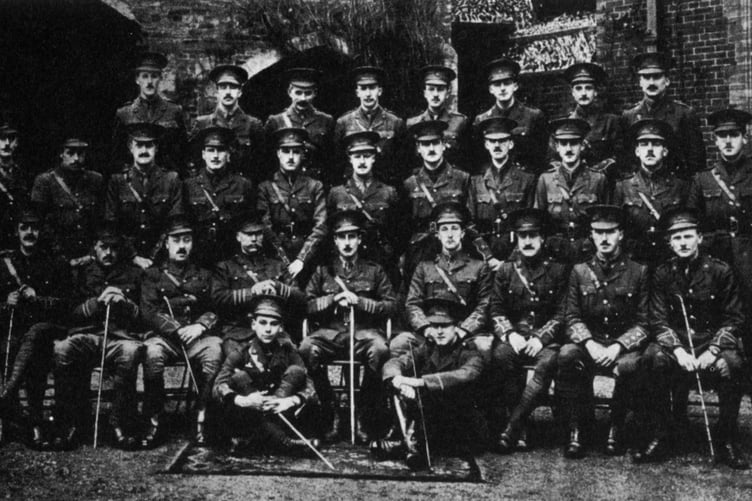
Dickebusch and Kemmel
By June 12th 1915, the amalgamated regiment was back in the front line - this time at Bois Carre near Dickebusch to the south of Ypres. Here they remained until June 19th. The battalion history records that "this part of the line was a pleasant change, but was unfortunately not free from casualties". Before they were relieved, the amalgamated regiment had lost 7 killed and 32 wounded, mostly during severe shelling of B Company on June 17th. The regiment had two more spells in the front line before leaving this area, from June 26th-July 3rd and July 11th-14th. Fortunately, casualties were lighter - 2 killed and 8 wounded.
On July 19th, the battalion were sent for the first of two tours in the front line at Kemmel - July 19th-22nd and July 28th-August 2nd. Here the regiment took part in the successful counter-mining of a German mine directly under the front line. On August 2nd, Captain Walbeoffe-Wilson, who had only joined the battalion on July 26th, was shot through the head as he peered over the parapet. The regiment was then relieved and marched to billets at Locre.
On July 5th the first steps had been taken to reform the original three battalions of the regiment. The 2nd Monmouths were detached on July 24th and the 1st and 3rd Battalions parted company on August 11th. The newly re-formed 3rd Mons were organised into four new companies, A, B, C and D, under Lieutenant JM Jones, Captain HG Tyler, Lieutenant LD Whitehead and Lieutenant HA Hodges. They were also re-attached to the 83rd Brigade and returned to the front line at Kemmel on August 22nd-28th. They were once again alternating in the front line with the 5th King’s Own Royal Lancaster Regiment.
On September 2nd, the 3rd Mons received orders to join the 49th Division as one of the new Pioneer Battalions.
The Yser Canal
During 1915, it became clear that the digging of fire trenches and communication trenches and the construction of light railways and bridges required specialist skills and knowledge and that there was a need for specialized units to do this work who were also fully trained infantrymen. It was soon recognised that units raised in mining areas had all the necessary experience and skill to fulfil this role and so the idea of the Pioneer Battalions took shape. All three battalions of the Monmouthshire Regiment became the pioneer battalions for their respective divisions.
At the beginning of September 1915, the 3rd Mons were sent to the Yser Canal front just north of Ypres.
The canal and the front line were below sea level in this area and flooding and mud was a constant problem. The battalion set about the construction of a series of drainage ditches to ease the problem. On September 21st, B and D companies moved out from the chateau grounds to "Dunbarton Dug-outs" on the west bank of the canal and started work. A and C companies remained at Elverdinghe and the two groups relieved each other every six days.
Work was carried out at night and the conditions were terrible. The Germans occupied Pilckhem Ridge to the east and the whole area was constantly shelled and swept by machine-gun fire. To cross the canal, soldiers had to use small temporary foot bridges, described by the battalion's historians as "very unhealthy, as they were open to enfilading machine-gun and shell fire from the German positions". There was a constant stream of casualties. Added to this, the ground was boggy; men often sank up to their waists in mud and had to spend weeks in wet clothing in bitter cold without hot food.
On the morning of December 19th, the chateau and canal came under heavy shell fire followed closely by a gas attack. All four companies moved into the trenches to reinforce the front line against the expected German attack. The attack never came but the battalion was shelled all day and all the following night and had 40 men killed or wounded. Lance-Corporal Dixon and Private Moore were later awarded the Distinguished Conduct Medal for rescuing wounded men and bringing them in through wrecked trenches and over the rickety wooden bridges across the canal.
On December 27th, the battalion was taken out of the front line and received orders to leave the Yser Canal. At 2.30 pm on December 29th, the whole battalion paraded in the grounds of Elverdinghe Chateau prior to moving out. As the men fell in, "an ominous sound was heard, like an oncoming railway train" and 17 inch shells began to burst among the ranks. In a few seconds, 39 men were killed and 30 wounded. Among the dead were many of the men who had survived the slaughter of Ypres.
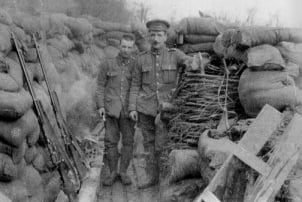
The Somme
For most of January 1916, the 3rd Mons were rested but, by February 14th, they had been moved to the Somme sector to help prepare for the "big push" which everyone knew was to come. The various companies set about their new tasks - A Company repairing roads near Bouzincourt, B Company building a light railway through Aveluy Wood across the Ancre Marshes and on to Thiepval Wood and C and D Companies working on "Northumberland Avenue" a new road running from Bouzincourt to Martinsaart.
Although the rest of the 49th Division were relieved on March 5th, the 3rd Mons were left to carry on their pioneer work in the "forward area". They were split up to work on various engineering schemes throughout April and May. D Company began construction of a new road from Forceville to Englebelmer which became known as "Monmouth Road". It was completed on June 20th. By this time, tension was running high as the opening for the Battle of the Somme had been set for July 1st, 1916. On June 24th, the 3rd Mons were re-united as a battalion and ordered to re-join the 49th Division. They were marched back to Bouzincourt and reached their destination 2 o'clock on the morning of July 1st.
When the British attack began, the battalion was in support of the 36th (Ulster) Division who were attacking the Schwaben Redoubt - a formidable German strongpoint - through the Thiepval Wood. By July 3rd, the battalion was digging the new British front line at the Schwaben Redoubt and Ancre. Here they came across the dead and wounded of the terrible fighting that had taken place over this ground. They also came under heavy shelling and German grenade attacks. The site of these trenches is now marked by the Ulster Memorial Tower.
On July 6th, A Company came under attack while digging trenches near the German lines captured by the 49th Division. The pioneers had to become infantrymen again and were ordered to hold the line until the next morning. 14 men were killed or wounded and Second-Lieutenant Straker of Abergavenny subsequently died of his wounds. On July 9th, A and D Companies helped hold off another German attack and four men were awarded gallantry cards. On July 16th, B Company came under heavy shell fire while repairing an ammunition dump and lost 19 killed and wounded.
The battalion spent the whole of July under battle conditions and suffered heavy casualties. On August 5th, they received news that it was now impossible to reinforce the Monmouthshire Regiment as a whole and that the 3rd Battalion was to be broken up to supply drafts for the 1st and 2nd.
On August 14th, 200 men left to join the 2nd Battalion and on August 24th the remainder, 252 men, left to join the 9th Entrenching Battalion - they were later transferred to battalions of the Welch Regiment and Royal Welch Fusiliers. The 3rd Mons had been broken up.
In writing the history of the 3rd Mons in World War 1, I have really only collated the stories and archives that have gone before. Frank Olding’s “Hell Let Loose” 3rd Battalion, The Monmouthshire Regiment in World War 1 produced for Abergavenny Local History Society in 2015, archives of the Regimental Museum of The Royal Welsh, Brecon and Abergavenny Museum tell the story with accuracy and compassion, a fitting tribute to the men of North Monmouthshire who cheerfully marched off to war, and so many never came back.
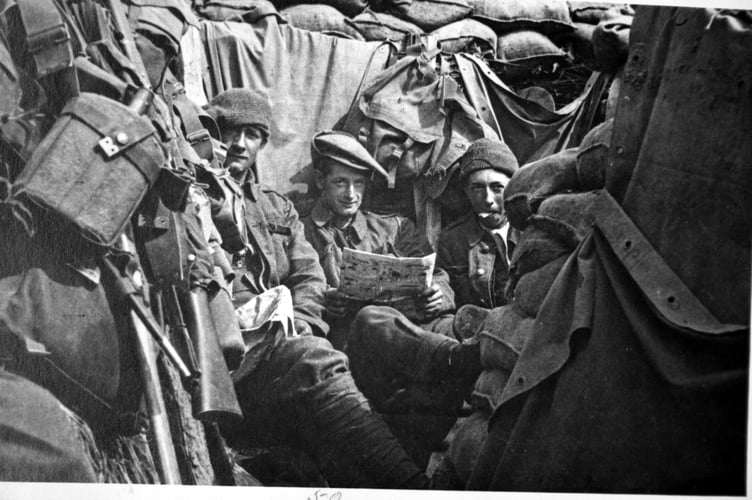
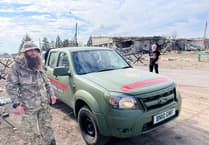
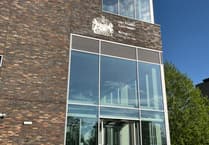

.jpeg?width=209&height=140&crop=209:145,smart&quality=75)
Comments
This article has no comments yet. Be the first to leave a comment.